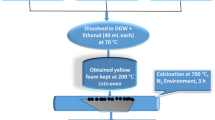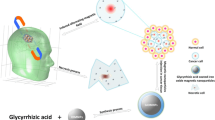Abstract
Fe3O4-HDTMS nanocomposites were prepared and studied using Fourier transform infrared spectroscopy (FTIR), transmission electron microscopy, X-ray analysis, thermal analysis (TGA), dynamic light scattering analysis, magnetic and specific loss power (SLP) measurements. FTIR results showed that during the modification, the formation of the silane coating occurs due to the appearance of the magnetite–O–Si–R bond. According to TGA results, the mass loss in the range of temperatures 410–650 °C is due to the destruction of covalent bonds Fe–O–Si. The Si–O–R coating leads to the decrease in the absolute value of the effective saturation magnetization due to the presence of a non-magnetic phase (coating) in the sample, but the coercivity increases with the coating thickness due to higher effective values of the magnetic anisotropy of the magnetostrictive nature. The thermal response of NP-based dispersions in silicone and oleic acid was shown that SLP value is higher for magnetic material dispersions in Lipiodol and oleic acid compared to silicone-based dispersions. This can be explained by the contribution of both Neel and Brownian relaxation processes. However, in the case of silicone-based dispersion, Brownian relaxation is negligible because of NP immobilization in viscous silicone matrix. As it is to the effect of coating on SLP, this is clearly evident in the case of silicone dispersions. The study of the heating ability of dispersions based on HDTMS-modified Fe3O4 NPs showed that the coating does not significantly decrease the SLP values.









Similar content being viewed by others
References
Ansell RJ, Mosbach K (1998) Magnetic molecularly imprinted polymer beads for drug radioligand binding assay. Analyst 123(7):1611–1616. https://doi.org/10.1039/A801903G
Chiarakorn S et al (2007) Influence of functional silanes on hydrophobicity of MCM-41 synthesized from rice husk. Sci Technol Adv Mater 8:110–115. https://doi.org/10.1016/j.stam.2006.11.011
Cótica LF et al (2010) Surface spin disorder effects in magnetite and poly(thiophene)-coated magnetite nanoparticles. J Appl Phys 108:064325. https://doi.org/10.1063/1.3488634
Dutz Z et al (2007) Hysteresis losses of magnetic nanoparticle powders in the single domain size range. J Magn Magn Mater 308:305–312. https://doi.org/10.1016/j.jmmm.2006.06.005
Geraldes C, Laurent S (2009) Classification and basic properties of contrast agents for magnetic resonance imaging. Contrast Media Mol Imaging 4:1. https://doi.org/10.1002/cmmi.265
Gordon RT et al (1979) Intracellular hyperthermia a biophysical approach to cancer treatment via intracellular temperature and biophysical alterations. Med Hypotheses 5:83–102. https://doi.org/10.1016/0306-9877(79)90063-X
Howarter JA, Youngblood JP (2006) Optimization of silica silanization by 3-aminopropyltriethoxysilane. Langmuir 22:11142–11147. https://doi.org/10.1021/la061240g
Johannsen M et al (2007) Thermotherapy of prostate cancer using magnetic nanoparticles: feasibility, imaging, and three-dimensional temperature distribution. Eur Urol 52:1653–1661. https://doi.org/10.1016/j.eururo.2006.11.023
Jordan A et al (1997) Effects of magnetic fluid hyperthermia (MFH) on C3H mammary carcinoma in vivo. Int J Hyperth 13(6):587–605. https://doi.org/10.3109/02656739709023559
Kaman O et al (2011) The magnetic and hyperthermia studies of bare and silica-coated La0.75Sr0.25MnO3 nanoparticles. J Nanopart Res 13:1237–1252. https://doi.org/10.1007/s11051-010-0117-x
Kannan MK (2010) Biomedical nanomagnetics: a spin through possibilities in imaging, diagnostics, and therapy. IEEE Trans Magn 46(7): 2523–2558. https://doi.org/10.1109/2FTMAG.2010.2046907
Kong WK et al (2007) Nanoparticulate carrier containing water-insoluble iodinated oil as a multifunctional contrast agent for computed tomography imaging. Biomaterials 28:5555–5561. https://doi.org/10.1016/j.biomaterials.2007.08.044
Nakamoto К (1997) Infrared and Raman spectra of inorganic and coordination compounds, Part A. Theory and applications in inorganic chemistry. Wiley, New York
Neouze MA, Schubert U (2008) Surface modification and functionalization of metal and metal oxide nanoparticles by organic ligands. Monatsh Chem 139:183–195. https://doi.org/10.1007/s00706-007-0775-2
Okawa K et al (2006) Heating ability of magnetite nanobeads with various sizes for magnetic hyperthermia at 120 kHz, a noninvasive frequency. J Appl Phys 99:08H102. https://doi.org/10.1063/1.2173208
Popplewell J, Sakhnini L (1995) The dependence of the physical and magnetic properties of magnetic fluids on particle size. J Magn Magn Mater 149(1):72–78
Randy de Palma et al (2007) Silane ligand exchange to make hydrophobic superparamagnetic nanoparticles water-dispersible. Chem Mater 19:1821–1831. https://doi.org/10.1021/cm0628000
Reimer P, Balzer T (2003) Ferucarbotran (Resovist): a new clinically approved RES-specific contrast agent for contrast-enhanced MRI of the liver: properties, clinical development, and applications. Eur Radiol 13(6):1266–1276. https://doi.org/10.1007/s00330-002-1721-7
Sahoo Y et al (2001) Alkyl phosphonate/phosphate coating on magnetite nanoparticles: a comparison with fatty acids. Langmuir 17: 7907–7911. https://doi.org/10.1021/la010703+
Salmio H, Brühwiler D (2007) Distribution of amino groups on a mesoporous silica surface after submonolayer deposition of aminopropylsilanes from an anhydrous liquid phase. J Phys Chem C 111:923–929. https://doi.org/10.1021/jp0651440
Smolkova I et al (2015) Correlation between coprecipitation reaction course and magneto-structural properties of iron oxide nanoparticles. Mater Chem Phys 155:178–190. https://doi.org/10.1016/j.matchemphys.2015.02.022
Sun H et al (2013) Targeted hyperthermia after selective embolization with ferromagnetic nanoparticles in a VX2 rabbit liver tumor model. Int J Nanomed 8:3795–3804. https://doi.org/10.2147/IJN.S50373
Thiesen B, Jordan A (2008) Clinical applications of magnetic nanoparticles for hyperthermia. Int J Hyperther 24(6):467–474. https://doi.org/10.1080/02656730802104757
Tian Z et al (2018) Magnetic mesoporous silica nanoparticles coated with thermo-responsive copolymer for potential chemo- and magnetic hyperthermia therapy. Micropor Mesopor Mater 256(1):1–9. https://doi.org/10.1016/j.micromeso.2017.07.053
Tinkle S (2014) Nanomedicines: addressing the scientific and regulatory gap. Ann NY Acad Sci 1313:35–56. https://doi.org/10.1111/nyas.12403
Torres-Lugo M, Rinaldi C (2013) Thermal potentiation of chemotherapy by magnetic nanoparticles. Nanomedicine 8(10):1689–1707. https://doi.org/10.2217/nnm.13.146
Tran N, Webster TJ (2010) Magnetic nanoparticles: biomedical applications and challenges. J Mater Chem 20:8760–8767. https://doi.org/10.1039/C0JM00994F
Tsutaoka T (2003) Frequency dispersion of complex permeability in Mn–Zn and Ni–Zn spinel ferrites and their composite materials. J Appl Phys 93:2789–2796. https://doi.org/10.1063/1.1542651
Tsutaoka T (2013) Analysis of the permeability spectra of spinel ferrite composites using mixing rules. In: IEEE International Symposium on Electromagnetic Compatibility, pp 545–550. https://doi.org/10.1109/ISEMC.2013.6670473
Vikesland PJ et al (2007) Particle size and aggregation effects on magnetite reactivity toward carbon tetrachloride. Environ Sci Technol 41:5277–5283. https://doi.org/10.1021/es062082i
Wei W et al (2015) Recent progress on magnetic iron oxide nanoparticles: synthesis, surface functional strategies and biomedical applications. Sci Technol Adv Mater 16(2):023501. https://doi.org/10.1088/1468-6996/16/2/023501
Xu L, Wang L, Shen Y et al (2015) Preparation of hexadecyltrimethoxysilane-modified silica nanocomposite hydrosol and superhydrophobic cotton coating. Fibers Polym 16:1082. https://doi.org/10.1007/s12221-015-1082-x
Xue S et al (2014) Iodinated oil-loaded, fluorescent mesoporous silica-coated iron oxide nanoparticles for magnetic resonance imaging/computed tomography/fluorescence trimodal imaging. Int J Nanomed 9:2527–2538. https://doi.org/10.2147/IJN.S59754
Yarovsky I et al (1995) Influence of the chain length and surface density on the conformation and mobility of n-alkyl ligands chemically immobilized onto a silica surface. Anal Chem 67:2145. https://doi.org/10.1021/ac00109a038
Yoshida W et al (2001) Multilayer alkoxysilane silylation of oxide surfaces. Langmuir 17:5882–5888. https://doi.org/10.1021/la001780s
Yu X, Zhu Y (2016) Preparation of magnetic mesoporous silica nanoparticles as a multifunctional platform for potential drug delivery and hyperthermia. Sci Technol Adv Mater 17(1):229–238. https://doi.org/10.1080/14686996.2016.1178055
Zhu Y, Tao C (2015) DNA-capped Fe3O4/SiO2 magnetic mesoporous silica nanoparticles for potential controlled drug release and hyperthermia. RSC Adv 5:22365–22372. https://doi.org/10.1039/C5RA00701A
Zhu MQ et al (2007) Surface modification of semiconductor quantum dots through reactive coating of silanes in toluene. J Mater Chem 17:800. https://doi.org/10.1039/B614432B
Acknowledgements
This article was written with the support of Dr. Natalia Kazantseva (Centre of Polymer Systems, Tomas Bata University in Zlin, Czech Republic) and the National Slovak Scholarship Programme for the Support of Mobility (SAIA).
Author information
Authors and Affiliations
Corresponding author
Ethics declarations
Conflict of interest
The authors declare that they have no competing interests. All authors read and approved the final manuscript.
Additional information
Publisher's Note
Springer Nature remains neutral with regard to jurisdictional claims in published maps and institutional affiliations.
Rights and permissions
About this article
Cite this article
Storozhuk, L., Iukhymenko, N. Iron oxide nanoparticles modified with silanes for hyperthermia applications. Appl Nanosci 9, 889–898 (2019). https://doi.org/10.1007/s13204-018-0777-x
Received:
Accepted:
Published:
Issue Date:
DOI: https://doi.org/10.1007/s13204-018-0777-x




